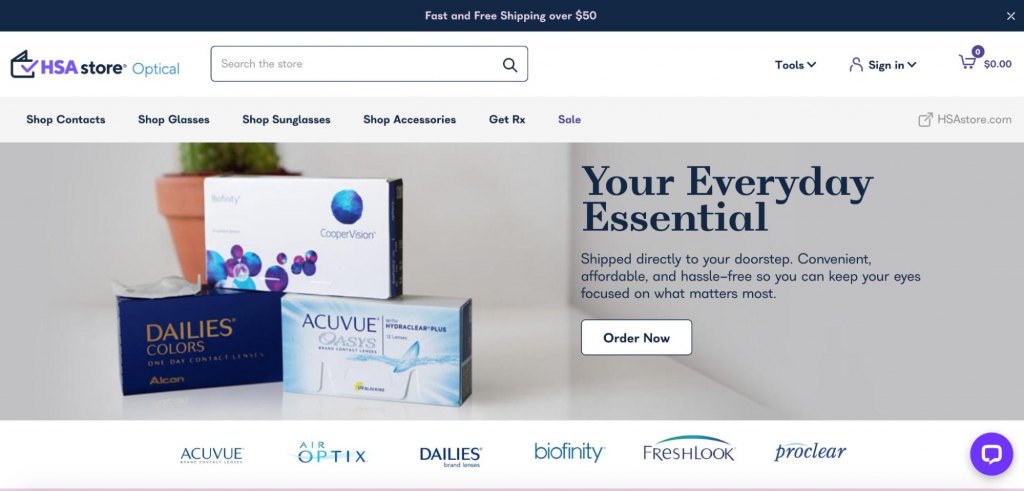Did you know the global medical e-commerce market reached $181 billion in 2019?
As you might expect, both B2C and B2B medical e-commerce sales saw an exponential rise in 2020 in the midst of the global COVID-19 pandemic.
In fact, the global medical e-commerce market is estimated to surge to over $435 billion by 2025. This change signals a growing demand for online healthcare and medical solutions by both businesses and consumers.
Medical e-commerce is changing how consumers and businesses shop for healthcare and medical products. Traditionally, people went to brick and mortar stores to purchase medical supplies, and businesses worked with distributors and in-person pharmaceutical sales representatives. Yet the increasing accessibility and use of online solutions are causing more consumers and companies to look for ways to purchase healthcare products online.
Now, more customers — of all ages — are buying everything from medications and durable medical equipment, such as daily living aids, hospital-style beds for home use, wheelchair ramps, wheelchairs, and canes, to disposable medical supplies like personal protective equipment (PPE), gloves, bandages, and disposable medical tools online.
Because consumers and businesses spend more money online on medical products, we’re sharing a guide to medical e-commerce in 2021.

Medical E-commerce Guide
What does medical e-commerce consist of?
Technology advances and the willingness of consumers and businesses to use online solutions have led to a growing medical e-commerce industry.
Healthcare e-commerce consists of both business-to-business and business-to-consumer sales. For instance, many clinics, medical practices, and hospitals are turning to e-commerce solutions to get their medical supplies.
Adroit Marketing Research reports that hospitals were some of the largest medical e-commerce buyers in 2018 at 53 percent of the addressable market share. The company predicts this trend to continue through 2025.
Medical e-commerce can be broken down into four main types of businesses:
- Telemedicine websites
- Medical supply and equipment stores
- Online pharmacies
- Healthcare marketplace websites
Telemedicine websites
Instead of selling a product, telemedicine websites and apps provide an online doctor-to-patient portal and service. This service-based e-commerce approach can help increase how quickly the doctor sees a patient. It also can save the patient time, leading to increased customer satisfaction, and increase access to care, especially for individuals in rural areas.
Not all medical issues can be dealt with through telemedicine. However, it can remove many barriers to healthcare and make it easier for consumers to reach their doctor or healthcare team for more routine tasks such as prescription refills.
Medical supply and equipment stores
In recent years, the online medical supplies industry has grown rapidly with this shift away from brick-and-mortar shopping to online, causing an increase in industry revenue. These types of online stores focus on physical, non-prescription products like devices and medical consumables. These e-commerce sites focus on individual consumers, healthcare institutions, or both.
Online pharmacies
Many consumers are turning to online pharmacies for their medications. Online pharmacies can save people time and money. They can also help ensure that customers don’t forget to refill medicines if they use an auto-delivery service. Medications made up 66 percent of the global market share in 2018 and are anticipated to continue growing.
According to Statista.com, the top e-commerce pharmacy sites are big names like Walgreens, which generated nearly $1.5 billion in 2019, and CVS, which made over $1 billion. However, the launch of Amazon’s pharmacy platform in November 2020 may change where consumers shop online for medications.
4 benefits of the medical industry adopting e-commerce
As the industry grows, establishing an e-commerce store can be a good opportunity for medical and healthcare practices that want to grow their business further. Here are four benefits of medical e-commerce:
1. Increase sales by reaching more customers.
A medical e-commerce website is always available, making it easy for customers to buy whenever they are ready. As a result, your website becomes a sales representative that’s always working for you. It’s also possible for your site to reach customers who might live in other places, helping you increase your sales.
Additionally, an online presence can make it easier for consumers to access information, services, and products, no matter where they are located. People don’t need to live near expert care or a store that offers the products they need.
2. Make it easier for consumers and businesses to research products.
More consumers and businesses want to research products on their own, a more self-service approach. For example, 94 percent of business-to-business buyers are researching products online as an initial step.
An e-commerce site containing content that helps buyers learn about products, make decisions about what they need, and then investigate specific products for sale can facilitate buyers’ search and lead to sales. In addition, customers appreciate having the ability to compare products and prices easily.
You can also enhance your customer’s online journey by using UX tools that guide visitors toward the products or services that will best help them.
3. Provide a more convenient patient experience.
Consumers and businesses are looking for streamlined, user-friendly experiences when purchasing medical products. In addition, a quality customer experience can turn visitors into loyal customers who tell others about your business.
Medical e-commerce businesses can capitalize on the variety of tools commonly used on e-commerce sites, such as educational articles, smart search functions, chatbots, and more to provide customers with exceptional service. For example, providing high-quality content that helps buyers determine which products best fit their needs can help medical e-commerce sites build trust with consumers.
You can also pair different types of services together to provide a streamlined, smooth customer experience. For instance, after a patient attends a telemedicine appointment, their doctor could submit their medication subscription to an online pharmaceutical e-commerce site, which delivers the medication directly to the patient’s home the same day.
As technology advances continue, increasing the convenience of healthcare and purchasing for consumers can lead to a better overall consumer experience as well as potentially increase compliance with doctor recommendations and reach more people.
4. Manage your supply chain and inventory more efficiently.
Consumers and businesses want to know that the products they need are available in the amounts they require before they make a purchase. Fortunately, technology allows e-commerce sites to maintain real-time inventory status, so buyers always know what’s available. Having this level of transparency in your inventory status can help build confidence and trust in your service and save your customers time.
4 challenges of medical e-commerce
While medical e-commerce will continue to grow, the industry will face unique challenges in meeting customers’ needs. Here are four challenges to consider when running a medical e-commerce business.
1. Navigate the maze of healthcare compliance regulations.
Complying with the various regulations involved in healthcare can be a significant challenge that keeps some businesses out of medical e-commerce. For instance, if your e-commerce site uses a person’s personal protected health information, you’ll need to follow Health Insurance Portability and Accountability Act (HIPAA) regulations to ensure the information is safe.
HIPAA regulations are extensive, and you can face legal penalties if your e-commerce site violates them. Plus, you’ll likely lose the trust of customers. That’s why it’s critical for medical e-commerce sites to use e-commerce software tools that are fully HIPAA compliant.
This only becomes more complicated when you expand outside of your home country.
2. Help older customers get comfortable using your website.
One of the few bright spots of the global pandemic is that it forced a lot more people to use the internet more regularly.
However, some folks, largely senior citizens, are still more resistant to accessing information and buying things online.
If your medical e-commerce site mainly caters to the octogenarian crew and older, you may need to rely heavily on in-person and direct mail strategies to reach them initially. Or you may need to find ways to communicate services to seniors’ younger loved ones who may be more open to technology solutions.
3. Use enhanced data security best practices.
As part of HIPAA, medical e-commerce sites need to ensure their data is secure, accessible by authorized personnel, and safe against cyber attacks. Securing data is also necessary to build trust among your customer base.
To ensure sensitive data is secure, you may need to use technical safeguards like data encryption, regular audits, HIPAA-compliant email software, HIPAA-compliant surveys, and HIPAA-compliant forms. Also, make sure your staff is trained in compliance issues.
4. Ensure you sell only verified and legitimate products.
As more consumers turn to websites for medical supplies and medications, there’s an increased risk of people unknowingly buying from fraudulent platforms. This risk is even greater with online pharmacy sites that aren’t verified or that import medications.
As more consumers turn to online pharmacies to save time and money, it will be important to educate people about how to find safe, secure, and verified websites — for instance, educating consumers on the importance of looking for online pharmacies that are approved by the National Association of Boards of Pharmacy (NABP).
How to incorporate e-commerce into your pharmacy or medical practice
Incorporating e-commerce into your pharmacy or medical practice can provide customers with the ease of use and convenience they’re looking for. Here are some strategies to help you start breaking into medical e-commerce.
1. Determine what to sell on your website.

This admittedly depends on what types of products you sell and whether you sell primarily B2B or B2C.
As we alluded to earlier, consumers have become more comfortable buying medical supplies, devices, equipment, and pharmaceuticals online through Amazon or directly through specialized medical e-commerce stores like Blooms The Chemist.
Here’s an example of a B2B medical e-commerce store that uses BigCommerce to sell personal protective equipment to wholesalers and distributors.

Regardless of what you sell or who you sell to, your online store needs to reflect what your customers associate with you to be successful.
2. Register your online pharmacy website with NABP.
As medications become easier to buy online, more consumers are skipping the trip to their local pharmacy and buying online from the convenience of home. Some of the more common uses of online pharmacies are for ongoing prescriptions like medications and supplies for diabetes or heart disease. It can be less convenient to use an online pharmacy for medications you need right away or only for a short time, such as an antibiotic.
Anytime you sell something that people consume, you need to reassure your customers that you’re a reputable online pharmacy selling safe medications, not some fly-by-night entrepreneur looking to make a quick buck selling homemade supplements from your garage.
Registering with NABP and receiving accreditation shows that your site meets the highest standards of pharmacy care. This is a requirement in some areas. It also helps you become a legitimate merchant for major credit card companies like Mastercard and Visa.
3. Make your e-commerce site easy for customers to navigate.

Buyers expect a convenient, easy shopping experience online no matter whether they’re shopping on their computer, tablet, or smartphone. If they can’t quickly find what they’re looking for, they will leave and go to one of your competitors. Take the time to create a website that’s responsive, clear, and easy to navigate.
For example, HSA Store Optical has a clean design and a great user experience. Anyone looking to buy glasses, contacts, or related eyewear and eye care products can find what they’re looking for easily.
4. Ensure your e-commerce site and any additional software you use is HIPAA compliant.
Make sure that your site follows all regulations, including for data security. This means having HIPAA-compliant forms and a Business Associate Agreement so your company can collect health information safely and securely.
Failure to comply can result in costly legal issues and cause you to lose the trust of your customers. You can either ensure you meet these regulations on your own or use tools or sites designed to comply with HIPAA.
5. Incorporate digital tools and solutions that integrate with your business.
Your website should also be easy for you and your team to use and navigate. Take time to explore tools that help you integrate with your existing business solutions and automate many repetitive tasks like data entry. You’ll save time and reduce errors.
For example, if you need to collect a patient’s prescription renewal after they place an order, you can set up a HIPAA-compliant form.
6. Develop a marketing plan
You’ll need a marketing plan to help ensure customers can find your store. Depending on the focus of your store and the regulations you must follow, you can use strategies like social media marketing, paid Google ads, or SEO-rich content that makes it easy for people to find your site when using search engines like Google and Bing.
Future of medical e-commerce
The future of medical e-commerce promises several exciting trends that are poised to reshape the healthcare and pharmaceutical industries:
- AI-Powered Diagnostics and Recommendations: Artificial intelligence is expected to enhance e-commerce platforms by offering personalized health recommendations and preliminary diagnostic support. This could help users choose suitable products based on their health data and history.
- Virtual and Augmented Reality (VR and AR): VR and AR could provide interactive experiences for users, allowing them to explore product details and even virtually “try on” medical equipment. This innovation would greatly aid decision-making, particularly for high-value or complex medical devices.
- Telemedicine and E-commerce Integration: As telemedicine grows, medical e-commerce will likely integrate with virtual healthcare platforms, allowing seamless prescriptions, consultations, and purchases within the same ecosystem.
- Blockchain for Enhanced Security: Blockchain technology could provide a layer of security in managing patient data and supply chain transparency, offering patients peace of mind regarding data privacy and product authenticity.
- Sustainable and Eco-friendly Practices: Environmentally conscious practices are emerging in medical e-commerce, with companies focusing on sustainable packaging, waste reduction, and carbon offsetting in deliveries.
- Improved Logistics for Fast and Safe Delivery: The need for swift, safe, and often temperature-controlled delivery methods is spurring innovations in logistics, which may include drone deliveries and advanced tracking technologies.
Conclusion
In sum, adopting medical e-commerce can grow your business while providing convenience to your customers and suppliers. Consumers are looking for convenience and more streamlined services and shopping experiences, including for healthcare. Incorporating an e-commerce store for your medical practice can help provide the ease your customers want while helping you increase your practice’s revenue.
Before setting up a medical e-commerce store, take time to determine what you want to sell and be sure you understand all regulations so you stay in compliance. If you want help setting up your store, consider looking into providers and platforms — like BigCommerce — that are familiar with the rules and regulations specific to the medical and healthcare industry.
Key Insights
- Market Growth: The global medical e-commerce market surged from $181 billion in 2019 to an estimated $435 billion by 2025, driven by both B2C and B2B sales.
- Changing Consumer Behavior: Increasing numbers of consumers and businesses are turning to online platforms to purchase a wide range of medical products, from medications to durable medical equipment.
- Telemedicine Expansion: Telemedicine websites offer a service-based e-commerce approach that enhances patient access to healthcare, especially in rural areas, by providing online doctor-patient interactions.
- Convenience and Accessibility: E-commerce provides a more convenient experience for patients and customers, facilitating easier research, comparison, and purchase of medical products.
- Challenges in Compliance: Medical e-commerce faces significant challenges in complying with healthcare regulations, such as HIPAA, which are crucial for protecting personal health information.
- Security Concerns: Ensuring data security and selling verified, legitimate products are critical to building trust and maintaining compliance in the medical e-commerce industry.
- Marketing Strategies: Successful medical e-commerce requires a well-thought-out marketing plan to ensure visibility and attract customers, which can include SEO, social media, and paid ads.
- Technology Integration: Incorporating digital tools that integrate with existing business solutions can streamline operations, reduce errors, and enhance the overall customer experience.
FAQ
- What is medical e-commerce? Medical e-commerce refers to the online sale of healthcare and medical products and services. This includes business-to-business (B2B) and business-to-consumer (B2C) transactions, covering telemedicine, medical supply stores, online pharmacies, and healthcare marketplace websites.
- What are the main types of medical e-commerce businesses? The main types of medical e-commerce businesses are telemedicine websites, medical supply and equipment stores, online pharmacies, and healthcare marketplace websites.
- What benefits does medical e-commerce offer to healthcare providers and consumers? Medical e-commerce offers several benefits, including increased sales opportunities, easier product research, improved patient experience, and more efficient supply chain and inventory management.
- What challenges does the medical e-commerce industry face? Key challenges include navigating complex healthcare compliance regulations, helping older customers adapt to online platforms, ensuring robust data security, and selling only verified and legitimate products.
- How can a pharmacy incorporate e-commerce into its operations? Pharmacies can incorporate e-commerce by determining what products to sell online, registering with the National Association of Boards of Pharmacy (NABP), ensuring their website is easy to navigate, complying with HIPAA regulations, and integrating digital tools that streamline business operations.
- Why is compliance with HIPAA important for medical e-commerce sites? Compliance with HIPAA is crucial because it ensures the protection of personal health information. Non-compliance can lead to legal penalties and loss of customer trust.
- How can medical e-commerce sites ensure data security? Medical e-commerce sites can ensure data security by using technical safeguards such as data encryption, regular audits, HIPAA-compliant email and survey tools, and training staff in compliance issues.
- What should consumers look for when choosing an online pharmacy? Consumers should look for online pharmacies that are verified and accredited by organizations such as the NABP, ensuring the pharmacy meets high standards of pharmacy care and sells legitimate products.























Leave a comment!